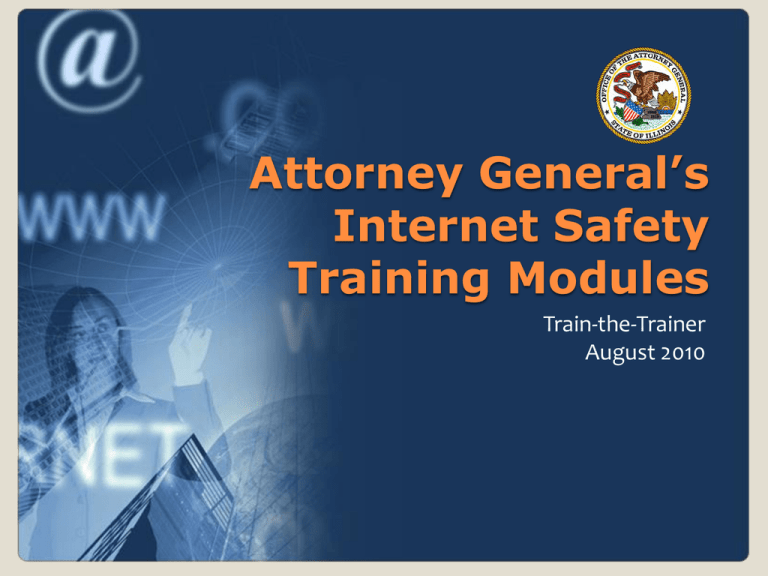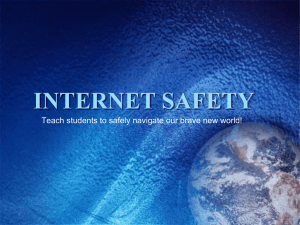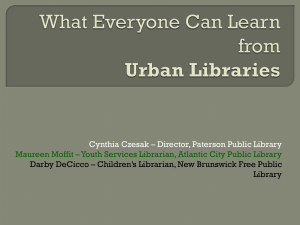
Attorney General’s
Internet Safety
Training Modules
Train-the-Trainer
August 2010
Internet Safety Modules
Digital
Citizen
Exploitation
Who R U
Cyberbullying
Sexting
Piracy
Content
“P”
Cyber Safety Survey:
The Results
4,231 students (grades 3-12)
24% have received an inappropriate picture
18% have been threatened by someone online
25% have said something inappropriate to
someone online or by text
24% have been approached by a stranger online
First cell phone: 11.17 years
First social networking profile: 12 years
Cyber Safety Survey: The Results, Office of the Illinois Attorney General, 2009
Social Media/Internet Usage
Social Media and Mobile Internet Use Among Teens and Young Adults, Pew Internet & American Life
Project, 2010, Amanda Lenhart, Kristen Purcell, Aaron Smith and Kathryn Zickuhr
Cell Phone Usage
75% of all teens (12-17) have a cell phone
58% of 12-year-olds have a cell phone
83% of 17-year-olds have a cell phone
66% text message
◦ 1/2 teens (50+ texts daily/1,500 monthly)
◦ 1/3 teens (100+ texts daily/3,000 monthly)
◦ Girls 14-17 (100+ daily…MOST)
Teens and Sexting, Pew Internet & American Life Project, 2009, Amanda Lenhart
Exploitation
Who are kids and teens talking to online?
◦ Predators: Strangers
One in seven U.S. teenagers who regularly log on to
the Internet say they have received an unwanted
sexual solicitation via the Web. Solicitations were
defined as requests to engage in sexual activities or
sexual talk, or to give personal sexual information.
◦ Cyber Stalking/Cyberbullying: “Frenemies”
21% of students surveyed felt uncomfortable with an
online conversation or text.
Cyber Safety Survey: The Results, Office of the Illinois Attorney General, 2009
Who R U
Content
Safe Posting Tips:
What to Post
“P”
Content
Use nickname only
Change the zip code
Use cartoons, drawings, or avatars
Make the profile private
Ask permission to add a friend
Safe Posting Tips:
What to Block
First and last names
Home telephone number
Cell phone number
Street address
Hometown/city of residence
Name of school
Name of favorite playground or
park
Date of birth
Credit card numbers
Images that identify you, your
school, or your hometown
“P”
Content
Risky Behavior = Unwanted
Outcomes
Talk to people in various places online
Add strangers to buddy list
Talk to strangers about sex
Look for pornographic content
Act in a rude or nasty manner online
Harass or post embarrassing information about others online
Post personal information in a profile, a blog or on a Web page
Share your personal information with strangers
Use of file sharing programs for pornographic images
Digital
Citizen
“P”
Who R U
Content
What is Cyberbullying?
When a child, preteen or teen is tormented, harassed,
humiliated, embarrassed or otherwise targeted by any other
person using the Internet or other digital communication
technology
What’s the Difference?
2.
Bullying
School
Direct (F2F)
3.
Limited Audience
1.
1.
2.
3.
4.
5.
6.
7.
Cyberbullying
Anywhere/Anytime
Anonymous
Larger Audience
More Kids Involved
Spreads Quickly
Victim NOT Participant
Permanent Record
The Reality
20.8% of kids have been bullied while online
14.3% have received mean or hurtful comments
13.3% have had rumors spread about them online
8.4% have been threatened over text
6.7% have had stolen passwords/someone impersonate them
5.0% had a mean or hurtful picture posted
Blog (Bash Boarding)
Create Web sites (Ex., Hot or Not, Sexual Orientation)
Send pictures (Ex., Locker room photos)
Send spyware and/or hack programs
Cyberbullying Victimization, Random sample of 10-18 year-olds from large school district in Southern U.S.,
Cyberbullying Research Center, 2010, Hinduja, S. and Patching, J.W.
Digital
Citizen
“P”
Content
Why?
Computer in bedroom?
Not much supervision
Work in groups
Feeling of anonymity
Fun/funny
◦ Empathy not fully developed
The “normal” place to communicate
Digital
Citizen
“P”
Content
Cyberbullying: A Student
Perspective
6 Focus Groups
◦ Middle and High Schools
◦ Urban, Rural, Suburban
Student Solutions
◦ Multifaceted solutions
◦ Punitive consequences are NOT sustainable
solutions
◦ Youth preferred mediation
◦ Work through issues in safe environment
◦ Peer-to-peer mediation
◦ Mentor program
Cyberbullying: A Student Perspective, Office of the Illinois Attorney General, 2010
Sexting
20% (22% girls & 18% boys) of teens have
sent/posted nude or semi-nude photos or
videos of themselves
39% (37% girls & 40% boys) of teens have
sent sexually suggestive messages
Sex and Tech: Results from a Survey of Teens and Young Adults, Cosmo Girl and The National Campaign
to Prevent Teen and Unplanned Pregnancy, 2008
Digital
Citizen
“P”
Who R U
Content
The Reality
44% of teen girls and boys say it is common for sexually
suggestive messages to be shared
36% of teen girls and 39% of teen boys say it is common for
nude or semi-nude photos to get shared
38% of teen girls and 30% of teen boys say they have had
sexually suggestive messages shared with them although they
were intended for someone else
25% of teen girls and 33% of teen boys have had nude or seminude photos shared with them although they were intended
for someone else
Sex and Tech: Results from a Survey of Teens and Young Adults, Cosmo Girl and The National Campaign
to Prevent Teen and Unplanned Pregnancy, 2008
Digital
Citizen
“P”
Who R U
Content
Who Receives Sext Messages?
71% of teen girls and 67% of teen boys are sending to
boyfriends/girlfriends
21% of teen girls and 39% of teen boys are sending to someone
they would like to date
15% are sending images to someone they only know online
Sex and Tech: Results from a Survey of Teens and Young Adults, Cosmo Girl and The National Campaign
to Prevent Teen and Unplanned Pregnancy, 2008
Digital
Citizen
“P”
Who R U
Content
Why?
Pressure from guys
Fun or flirtation
Sexy present
Response
Joke
Feel sexy
Not as many natural filters
Sex and Tech: Results from a Survey of Teens and Young Adults, Cosmo Girl and The National Campaign
to Prevent Teen and Unplanned Pregnancy, 2008
Digital
Citizen
“P”
Who R U
Content
Piracy – P2P
Peer-to-Peer networks have gained
enormous popularity with teens as a way
to trade music, movies and TV shows
◦ Trading copyrighted materials is illegal!
Limewire, Frostwire, Kazaa, BitTorrent,
e-donkey
Digital
Citizen
Module Review
Digital Citizen
A digital citizen is “someone who is able to think critically
about the ethical opportunities and challenges of the
‘digital world’ and make safe, respectful, and responsible
choices.” (Common Sense Media, 2010)
◦ Attributes of a good digital citizen:
Respects others (doesn’t respond to or post negative
comments)
Doesn’t steal (if you wouldn’t steal from a store, why
steal music, movies, videos)
Accepts personal responsibility (cell phones and
Internet)
Digital
Citizen
Ex., Cyberbullying, Sexting, Piracy
Grade-Appropriate Resources
Grades 3-5
◦ “Good Manners Everywhere” CyberSmart! Curriculum
Worksheet
Grades 6-8
◦ “Cyberbullying: Who, Me? Why Should I Care?”
CyberSmart! Curriculum Worksheet
Grades 9-12
◦ “Cyberbullying: Can’t Take It Back” Netsmartz Video and
Worksheet
Digital
Citizen
“Cyberbullying: Can’t Take It
Back” Netsmartz
Digital
Citizen
Module Review
“P”
Many tips for surfing the Internet safely start with the letter
“P.” Students should know that anything posted online is
both public and permanent, which is why it is important to
think before you post.
◦ Additional “P” Messages:
Permission
Privacy Settings
Password Protection
Personal Information
Ex., Exploitation, Cyberbullying, Sexting, Piracy
“P”
Grade-Appropriate Resources
Grades 3-5
◦ “Strong Passwords” CyberSmart! Worksheet
Grades 6-8
◦ “Playing and Staying Safe Online” iKeepSafe Video and
Worksheet
Grades 9-12
◦ “Post-to-be-Private” NS Teens Video and Worksheet
“P”
“Post-to-be Private” Netsmartz
“P”
Module Review
Who R U
There is a perceived sense of anonymity online. As a result,
some individuals pretend to be someone they are not.
Users can misrepresent their ages, gender, personalities,
location, and other information about themselves.
This module includes misrepresentation, false profiles, and
friending.
Closest
Friends
Friends
Acquaintances
Ex., Exploitation, Cyberbullying, Sexting
Who R U
Strangers
Grade-Appropriate Resources
Grades 3-5
◦ “Matching Game - Profiles: Who are You Talking To?”
Office of the Illinois Attorney General Worksheet
Grades 6-8
◦ “Two Truths and a Lie: Profile Edition” Office of the
Illinois Attorney General Worksheet
Grades 9-12
◦ “Julie’s Journey” Netsmartz Video and Worksheet
Who R U
Module Review
Content
Students also need to be aware of what information they
are posting and how they are representing themselves
online. This module includes what information should and
should not be included online.
◦ Limit the amount of personal information
Profiles, screen names, and e-mail addresses, examples
of identifying information, and how users represent
themselves online and in texts, photos, and video
◦ Appropriate self-representation
Ex., Exploitation, Cyberbullying, Sexting
Content
Grade-Appropriate Resources
Grades 3-5
◦ “Four Corners - To Report or Not to Report” Office of
the Illinois Attorney General Activity
Grades 6-8
◦ “Take Action Kit - Activity Sheet: Social Networking”
2SMRT4U Activity
Grades 9-12
◦ “Your Online Image” CyberSmart! Curriculum Worksheet
Content
Office of the Illinois Attorney General:
Internet Safety Web Site
Office of the Illinois Attorney General:
Cyberbullying Web Site
www.ebully411.com
Contact Information
Sarah Migas
(312) 793-4230
smigas@atg.state.il.us
www.ebully411.com
www.illinoisattorneygeneral.gov






